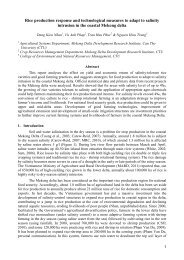start-with-the-park
You also want an ePaper? Increase the reach of your titles
YUMPU automatically turns print PDFs into web optimized ePapers that Google loves.
Planning green infrastructure<br />
43<br />
The importance of having<br />
a green space strategy<br />
GIS and o<strong>the</strong>r mapping tools<br />
should be used to develop<br />
an understanding of existing<br />
conditions and how planned<br />
interventions might affect<br />
local areas<br />
Through a comprehensive<br />
information ga<strong>the</strong>ring,<br />
community involvement and<br />
data analysis process, Wakefield<br />
Metropolitan District Council<br />
laid <strong>the</strong> groundwork for its green<br />
space strategy. The enabling<br />
work of CABE Space raised<br />
<strong>the</strong> political strategy’s profile<br />
clarifying both its links <strong>with</strong><br />
national policy and its essential<br />
role in implementing<br />
<strong>the</strong> Community Strategy<br />
CABE Space’s publication Green<br />
space strategies: a good practice<br />
guide 14 provides a comprehensive<br />
overview and a series of checklists<br />
explaining how local authorities can<br />
audit <strong>the</strong> current condition of <strong>the</strong> green<br />
assets in an area and identify what <strong>the</strong><br />
community wants. It describes how a<br />
strategy can be formulated to achieve<br />
<strong>the</strong>se aspirations. It is important to<br />
consider green spaces that are not<br />
managed by or in <strong>the</strong> control of <strong>the</strong> local<br />
authority, as <strong>the</strong>se are a vital component<br />
of <strong>the</strong> network, especially for biodiversity.<br />
The companion guide to PPG17,<br />
Assessing needs and opportunities<br />
(ANO) 15 , also offers guidance on how<br />
councils can establish <strong>the</strong> wishes of<br />
local communities and apply green<br />
space standards in a way that is<br />
equitable to both <strong>the</strong> communities<br />
and developers. It also provides a<br />
framework for determining <strong>the</strong> need<br />
for planning conditions or negotiating<br />
planning agreements.<br />
The baseline information includes:<br />
• Demographic profile of <strong>the</strong><br />
population and future trends<br />
• Assessment of needs<br />
• National, regional and<br />
local policy<br />
• Landscape/townscape/visual<br />
characteristics of <strong>the</strong> area<br />
• Ecological resources, including<br />
designations and targets<br />
from local biodiversity<br />
action plans<br />
• Heritage resources<br />
• Spatial planning context such<br />
as regeneration initiatives<br />
• Transport networks, including<br />
public transport links, pedestrian<br />
and cycle routes<br />
• An assessment of <strong>the</strong> quality,<br />
quantity and accessibility<br />
of current green space supply<br />
relative to demand<br />
• Existing levels of capital<br />
and revenue.





